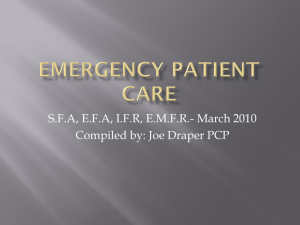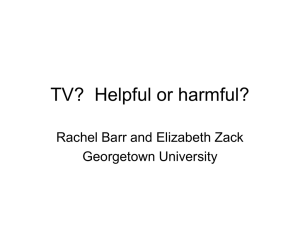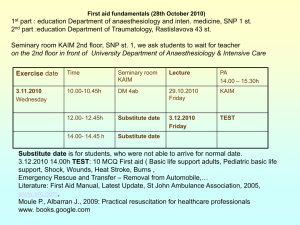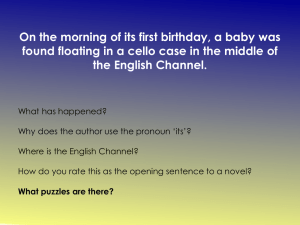Neonatal Resuscitation
advertisement
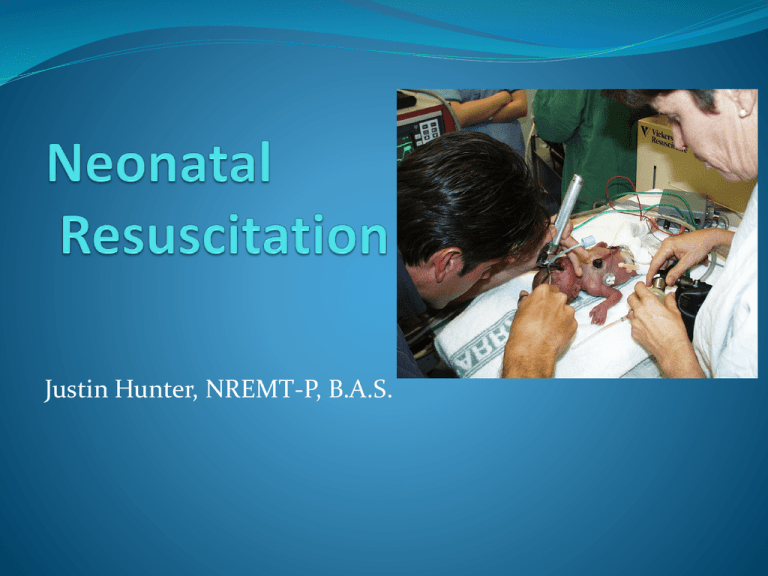
Justin Hunter, NREMT-P, B.A.S. Objectives for this lesson Changes in physiology that occur when a baby is born The sequence of steps to follow during resuscitation The risk factors that can help predict which babies will require resuscitation The equipment and personnel needed to resuscitate a newborn The importance of communication and teamwork among team members during resuscitation Why learn neonatal resuscitation? 4 million neonatal deaths occur each year world wide. Birth asphyxia accounts for 23% of these deaths Which babies require resuscitation? Approx 10% of newborns require some assistance to begin breathing at birth Less than 1% need extensive resuscitative efforts Over 90% of newborns are born with little to no difficulty Always needed by newborns! Assess baby’s risk for resuscitation Provide warmth Position, clear airway if required Dry and stimulate to breath Sometimes needed by newborns Give supplemental oxygen Assist ventilations Intubation Rarely needed!! Chest compressions Medication administration So,,,,How does a baby receive oxygen before birth? Only a very small amount of fetal blood actually passes through the lungs Fetal lungs are NOT functioning as a route to transport oxygen or to excrete CO2 Fetal alveoli are filled with fluid Arterioles that feed the lungs are generally constricted causing hardly any flow through the lungs Much of the blood that would normally go through the lungs simply bypasses the lungs through the ductous arteriosus. Some of this blood is then circulated through the body while the rest is circulated to the placenta through the umbilical cord. The placenta is where gas exchange takes place Then how does the newborn get oxygen into the lungs? First, the fluid in the alveoli is absorbed into the pulmonary lymph system. There is now 21% O2 available for gas exchange to take place in the alveoli. Second, the umbilical arteries constrict and then the umbilical arteries and veins are closed when the cord is clamped. This drastically increases systemic blood pressure. Finally, due to the increase in oxygen levels, the blood vessels in the lung tissue relax, allowing increased blood flow through the pulmonary arteries. cont…. As oxygen levels increase and pulmonary blood vessels relax, the ductous arteriosus begins to constrict Skin gradually turns from gray/blue to pink This entire process starts within a few moments of birth but the entire process will not be completed until hours or days after delivery. It can take up to 10 minutes to achieve on O2 saturation of 90% or greater What can go wrong with this transition? The lungs may not fill with air for some reason. The initial breaths may simply not be strong enough. The expected increase in blood pressure may not occur possibly due to blood loss or hypoxia The pulmonary arterioles may remain constricted after birth possibly due to inadequate filling of the lungs or hypoxia during delivery. Any perinatal stress may result in an initial period of rapid breathing followed by a period of primary apnea. During this time, stimulation will cause a resumption in breathing However, if the baby enters an additional period of apnea called secondary apnea, assisted ventilations will be required to reverse process. Three questions to ask!!! 1. Was he born at term? 2. Is he breathing or crying? 3. Does he have good tone? If yes to all 3 then toss baby to momma and you’re done!! But, if ANY answer is no, you should continue the initial steps of resuscitation Resuscitation flow diagram We’ve all heard this before!!! A B! C!! and D!!!!!! A=Airway Position the head and open the airway Clear as necessary May have to suction trachea (explained later) During this time you must evaluate if the baby is breathing AND if the heart rate is 100bpm or lower If the baby is not breathing or the heart rate is below 100, go straight to B!! B= Breathing If the baby is not breathing or the heart rate is below 100bpm you must immediately provide positive pressure ventilation, PPV. Apply pulse oximeter Provide PPV for 30 seconds and then reevaluate If the heart rates drops below 60bpm proceed straight to C!! C= Circulation Once you have determined heart rate is below 60bpm AND you have already tried PPV for 30 seconds,,,,start chest compressions. Intubation is recommended at this point After a minute or two of compressions, reevaluate the newborn If heart rate still below 60bpm, go straight to D!! D=Drug!! Administer epinephrine while continuing CPR Reevaluate….if heart rate still below 60 bpm repeat C and D,,,C,D,C,D,C,D,C, etc…… When heart rate rises above 60, you may stop compressions but continue PPV until heart rate is above 100bpm Important to note that this was all done with room air..21% We will discuss later when to use supplemental oxygen APGAR is only useful for documenting condition and/or relaying information 1 min and 5 min Some case studies…. A 24-year-old woman is in labor. Water broke 1 hour ago and the amniotic fluid was clear. She dilates progressively and a baby girl is born 3 hours later. The cord is clamped and cut and she begins to cry as she is dried with a warm towel. She was born at term and has good muscle tone. Stay with mom? Or proceed to A=airway? Next case… A woman presents at term in the early stages of labor. Her membranes have ruptured and the amniotic fluid was stained with meconium. At birth the baby has poor tone and minimal resp effort. Give to momma? Or proceed to A=airway?? Proceed to airway….. We never move passed a, b, or c until each one is completed Baby warmed, dried, and airway cleared of meconium. Trachea is intubated and suctioned and baby still has weak resp efforts Baby is stimulated and airway opened. Now, baby starts to breathe more effectively and heart rate is 120 Baby still has poor tone Give to momma? Or proceed to B=breathing?? Proceed to breathing… Baby still has poor tone 5 minutes after birth so blow- by oxygen is now given. Oxygen saturation is at 92% so o2 is discontinued per chart After 10 minutes heart rate is 150 and is breathing adequately with good tone Give to momma? Or proceed to C=circulation?? Give to momma!! Baby is still monitored while resting on mother’s chest Targeted SPo2 after birth….. 1 min 2 min 3 min 4 min 5 min 10 min 60-65% 65-70% 70-75% 75-80% 80-85% 85-95% Remember… Was the baby born at term? Is the baby breathing or crying? Is there good muscle tone? Meconium Suctioning Always mouth before nose!!! M comes before N How to assess for cyanosis The most rapid and visible indicator of the state of the baby’s oxygenation is the baby’s skin color Best determined by looking at the central part of the body Blue feet and blue hands are NOT a reliable indicator of poor perfusion Use pulse oximeter Remember that newborns come out starting around 60%SPo2 and gradually increase during their physiologic transitions Pulse oximeters must be placed where there is good CAPPILARY blood flow Fingers, palms, forehead, toes, ears, etc… Remember that neonates usually won’t require supplemental oxygen during the beginning of resuscitation Devices for PPV Many devices out there…. Prehospital will mostly only have a manual BVM or a vent Always start with BVM NEVER use a BVM on a neonate without a pop-off valve!! They should be rated around 30-40cm H2O Choose the appropriate sized BVM. Should have a volume of around 200mL Most people (neonate or adult) only require 4-6mL/kg When you see chest rise……..STOP! Rising heart rate is the MOST important indicator of successful resuscitation efforts Assess effectiveness of ventilation by listening for breath sounds and looking for CHEST movement Always start with 21% and then gradually increase oxygen use according to the chart Remember that the fetus’ lungs are filled with fluid and the first few PPV may require a slightly higher force than normal 3 possible reason for ineffective ventilations Inadequate seal between the mask and the baby’s face The baby’s airway is blocked Not enough pressure being used Rate?? Paramedics should be great this because they bag everyone at 50 times per minute!! 40-60 breaths per minute Gastric distention could also be a problem Distention puts upward pressure on the diaphragm, preventing full expansion of the lungs Distention may also cause regurgitation of gastric contents, which then may be aspirated Chest compressions When? How? Coordination When to stop? Case study…… Baby is born at term, limp, without respirations…. We did A then went to B,,,,baby is still not responding,,,,now we go to…………C Remember that we had to try 30 seconds of PPV before actually jumping to C Heart rate still remains below 60 bpm WHILE being limp and cyanotic Chest compressions are started with a ration of 3:1 Chest compressions are indicated whenever the heart rate is below 60 bpm, despite at least 30 seconds of effective PPV. We need at least 2 people present to properly and effectively do CPR Thumb technique is preferred Remember ‘sniffing’ position. Do not hyper extend Compress to a depth of 1/3 the diameter of the chest Allow FULL recoil One-and-two-and-three-and-BREATHE One-and-two-and-three-and-BREATHE One-and-two-and-three-and-BREATHE One-and-two-and-three-and-BREATHE One-and-two-and-three-and-BREATHE One-and-two-and-three-and-BREATHE During initial resuscitation..reevaluate every 30 seconds However, once compressions have started reevaluate about every 60 seconds Stop compressions once heart rate climbs beyond 60 If the baby still will not improve then we move to………………..D (we’ll get back to this) Intubation notes… Have all of your equipment ready before you need it Have the obvious equipment PLUS: CO2 detection devices Suction supplies Meconium aspirator BACKUP AIRWAY!!!! LMA or King ET Tube sizes,,,,,,no one ever memorizes the charts and formulas. Have several sizes ready. Close to the size of the nare or pinky Uncuffed! But, we want the biggest that will fit appropriately cont…. Consider cutting the tube to shorten it Stylets are not required Try to take only 5-10 seconds to actually stop CPR If suctioning meconium have an aspirator ready Have multiple ET tubes prepared as you typically can only get one good suction from each tube Do not suction longer than 5 seconds cont… Remember the gold standard for confirmation of ET tube placement is capnography waveform. Keep in mind that uncuffed ET tubes that are too small in diameter may actually allow blow-by around the vocal cords causing a problem with the waveform Breath sounds can echo throughout the thorax of a newborn A rapid increase in heart rate is the best indicator of effective PPV. Backup airways LMAs and/or King airways must be available as a backup device Some limitations: cannot suction trachea and do not protect as well as ETT against aspiration D= DRUGS!!! Venous access in the neonate The umbilical vein is the most quickly accessible direct IV route in the newborn. Yes, it is better than an IO. Direct path to the heart Usually reserved for hospitals and/or flight services Umbilical cord has 2 arteries and 1 big vein Alternatives? May be given ET but this is unreliable and makes for slow absorption time The ET may be used while another route is being established Prehospital: quickest route is obviously IO UVC route is still the preferred if available Epinephrine Epinephrine is not indicated before you have established adequate ventilation Yes, epi has beta effects that do increase strength and rate of cardiac contractions HOWEVER….. The most important effect of epi is the peripheral vasoconstriction, which will increase blood flow to the brain and the coronary arteries. Epi cont…. 1:10,000 should be used for neonates IV dose is 0.01 mg/kg which equates to 0.1 mL/kg in volume Dose should be doubled if giving ET IV: flush with 1cc after Epi cont….how will you draw it up?? A 1cc syringe will be needed to get the most accurate dose. Can either connect to stopcock and epi syringe Or, can draw up directly from epi container Get the right dose and don’t guess!! Possible hypovolemia… If there has been a placenta previa, or blood loss from the umbilical cord, the baby may be in hypovolemic shock Fluids may be indicated if the baby does not respond to ventilations, chest compression, AND epinephrine Must be isotonic: NaCl or LR Dose??? 10 mL/kg Never, ever, ever, ever,,,,,,,,EVER,,,,,hook up an IV fluid bag to a child under 1 without a Buretrol chamber, an IV pump, or a regular syringe Just a few cc’s too much can be massive fluid overload Special situations… Choanal atresia congenital blockage of the nasal airway Remember that newborns are nose breathers and any blockage of the nasal passage may inhibit respirations Test for choanal atresia by inserting a small suction catheter and feeling for resistance Insert OPA to help maintain airway Pharyngeal airway malformation Pharyngeal airway malformation Tongue falls into the pharynx and blocks the airway If you suspect this, first step is to place baby prone to help the tongue fall forward If this doesn’t help, you can nasally intubate the newborn. Not all the way to the trachea but rather to act as a long NPA Pneumothorax Spontaneous leaks in the lung are not uncommon Risk is increased dramatically if PPV is taking place If pneumo becomes a tension pneumothorax that is effecting breathing and circulation, chest decompression may be indicated Decompression with 18g or 20g should take place at 2nd intercostal space mid-clavicular OR 4th intercostal space anterior-axillary Attach stopcock or other one-way valve Narcotics?? Either from mother’s use or pain medicine given during labor could be passed to newborn Administration of narcan may be indicated if ALL OTHER steps have already been completed. Dose of narcan is 0.1 mg/kg and can be given just about any route Premies? Keep in mind that babies born earlier than 23 weeks have a small likelihood of survival What if the parents don’t want you to do CPR? Use good judgment and involve medical control When in doubt…..RESUSCITATE Questions???? www.EMSSuccess.org References Lancet. 2010;375:1969-1987 Neonatal Resuscitation. (2011) 6th edition Aehlert, B. (2010). Paramedic Practice Today: Above and Beyond. Volume 2. St. Louis, MO:Mosby JEMS Elsvier.
